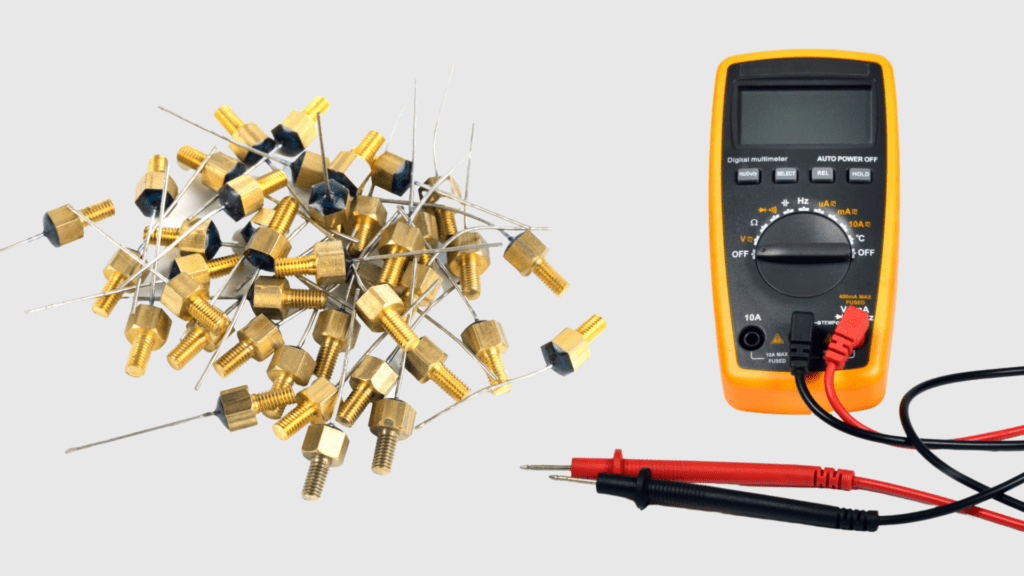
How to check the temperature sensor with a multimeter
Content
Is your car overheating?
Is the temperature needle on the dashboard stuck on hot or cold?
Are you also experiencing poor idling and difficulty starting the engine?
If your answer to these questions is yes, then the temperature sensor may be the culprit and you need to run tests on it to determine if it needs to be replaced or not.
Without wasting time, let's get started.

What is a temperature sensor?
The temperature sensor or coolant temperature sensor is a vehicle component that measures the temperature in the engine.
When measuring temperature, the coolant sensor sends either a hot or cold signal to the engine control unit (ECU), and the ECU uses these signals to perform several actions.
The ECU uses the temperature sensor data to properly adjust the fuel injection and ignition timing.
In some vehicles, the temperature sensor data is also used to turn the engine cooling fan on and off, or transmitted to a sensor on the vehicle's dashboard.

Symptoms of a faulty temperature sensor
Due to the role of the coolant temperature sensor in the engine and how it affects ECU functions, the symptoms of a bad sensor are easy to spot.
- Car overheating
A faulty temperature sensor can send a constant hot signal to the ECU, which means that when the engine needs cooling, the ECU does not respond appropriately and the fan never turns on.
The engine continues to heat up until it becomes overheated, which may cause a fire.
- Poor ignition timing
As mentioned earlier, the ECU also uses data from the temperature sensor to determine ignition timing.
This means that if the temperature sensor fails, starting the engine will be difficult due to incorrect ignition timing.
- Inaccurate fuel injection
A bad temperature sensor causes poor fuel injection into the engine, leading to a whole host of other symptoms.
These range from black smoke coming out of the tailpipe to low vehicle mileage, poor engine idling and general poor engine performance.
If these conditions are maintained for a long time, the engine may be damaged.
Temperature Sensor Testing Tools
There are two methods for checking the coolant temperature sensor, and these methods have their own special tools and equipment.
To check the temperature sensor you will need:
- Multimeter
- Hot and cold water
How to test a temperature sensor with a multimeter
Set the multimeter to DC voltage, remove the temperature sensor from the car, place the red probe on the far right pin and the black probe on the far left pin. Dip the sensor in hot and cold water and check the voltage reading on the multimeter.
This is the basic process for testing a temperature sensor with a multimeter, but that's not all.
- Find the temperature sensor
The temperature sensor is usually a small black device located near the thermostat housing.
To find the thermostat housing, you follow the hose that runs from the radiator to the engine.
At the end of this hose is the thermostat housing, and next to it is usually a temperature sensor.
This setting may vary depending on the vehicle model, but remains more common among modern vehicles.
However, for trucks, the temperature sensor could be found next to a metal cylinder in the cylinder block (intake manifold).
You have to remove that intake plenum to access it and hire a professional mechanic - the safest bet to avoid damaging the engine.
- Take out the temperature sensor
The temperature sensor is connected to the motor via a wire terminal.
It's connected to the wiring harness through its metal terminals and you just want to separate the two.
Just disconnect the sensor from the wiring harness.
PS: Before opening the car hood to find and remove the temperature sensor, make sure the engine is off and not running for at least 15 minutes. This is necessary so that he does not burn you.
Once you've found the temperature sensor and removed it from the engine, your multimeter comes into play.
- Multimeter pinout
Connect the multimeter wires to the temperature sensor terminals.
Some sensors may have up to 5 terminals, but make sure the sensors are placed on both ends of the sensor connector.
The use of crocodile clips greatly simplifies the whole process. When connecting the multimeter leads, you don't want them to touch each other.
You simply attach the red probe to the terminal on the far right and the black probe to the terminal on the far left.
- Cold water immersion sensor
Immersion of the sensor in cold and hot water is necessary to obtain a reference temperature for measurements.
You get about 180ml of water, put ice cubes in it, and make sure it's about 33°F (1°C). A digital thermostat might be helpful.
- Take measurements
Diagnosing a temperature sensor requires you to check that it is putting out the right amount of voltage.
To do this, you set the dial of the multimeter to DC voltage and record what the multimeter outputs.
If the multimeter is not reading, try reconfiguring the probes on the terminals.
If it still doesn't give any reading, then the sensor is bad and you don't need to run any further tests.
The correct multimeter reading is about 5 volts.
However, this depends on the temperature sensor model, so please refer to your vehicle owner's manual. If you get a reading, write it down.
- Hot water immersion sensor
Now immerse the sensor in about 180 ml of boiling water (212°F/100°C).
- Take measurements
With the multimeter still in the DC voltage setting, check the voltage reading and record it.
In this boiling water test, a good temperature gauge gives a multimeter reading of about 25 volts.
Of course, this depends on the model and you want to refer to the vehicle manual or the temperature sensor.
- Rate results
After you run these cold and hot water tests, you'll compare your measurements with the requirements for your particular vehicle model.
If the cold and hot measurements do not match, the sensor is defective and must be replaced.
On the other hand, if they match, the sensor is working correctly and your problems may be related to other components.
Here is a video that visually simplifies the process of running cold and hot water tests on a temperature sensor.
Checking the temperature sensor wires
You can test the sensor wires by using jumper cables to ground the wire harness to a nearby metal surface.
Start the engine, ground the wired sensors with the jumper cable and check the temperature sensor on the dashboard.
If the wires are in order, the gauge reads about halfway between hot and cold.
If you can't follow the wired path, we also have a guide for that.

Conclusion
The temperature sensor is a small component that plays a very large role in the health and performance of your engine.
If you notice symptoms, follow our instructions and use a multimeter to measure the voltage generated across its terminals.
Hiring a professional mechanic can be helpful if the steps seem a little daunting.
F.A.Q.
How do you know if your thermometer is broken?
Some symptoms of a bad temperature sensor include engine overheating, engine light coming on, black smoke from the exhaust, low mileage, poor engine idling, and difficulty starting the vehicle.
Why is my temperature sensor not moving?
The temperature gauge may not move due to problems with the temperature sensor. The pressure gauge can constantly hang on hot or cold, depending on when the gauge was damaged.
How to measure the resistance of a temperature sensor?
Set the multimeter to ohms, place the test leads on the sensor terminals, preferably using alligator clips, and check the resistance reading. The corresponding reading depends on the sensor model.
Does the temperature sensor have a fuse?
The temperature sensor does not have its own fuse, but uses a fusible wire to the instrument cluster. If this fuse is blown, the temperature sensor is not working and the fuse should be replaced.

